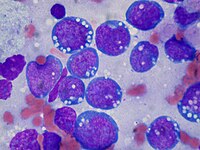
Photo from wikipedia
DDX3X is an RNA-helicase that unwinds RNA complexes and regulates mRNA translation [1]. The DDX3X protein is highly conserved between mice and humans (98%) and contains a helicase and an… Click to show full abstract
DDX3X is an RNA-helicase that unwinds RNA complexes and regulates mRNA translation [1]. The DDX3X protein is highly conserved between mice and humans (98%) and contains a helicase and an ATP-binding domain. The DDX3X gene is located on the X chromosome and escapes X-chromosome inactivation in human and mice. Consequently, females have two active DDX3X copies, while males carry only one, although the Y chromosome harbors a paralog called DDX3Y encoding a nearly identical protein (>90% homology). Recent large-scale sequencing studies revealed that DDX3X is mutated at significant percentages in many B cell malignancies: 30% of Burkitt Lymphoma (BL), 5% of diffuse large B cell lymphoma (DLBCL), 14% of primary mediastinal B cell lymphoma, as well as in 10% of Hodgkin’s Lymphoma, . . .. The majority are loss of function (LOF) mutations located within sequences coding for the helicase domain and thus abrogating DDX3X enzymatic activity. Gong and collaborators discovered that DDX3X mutations occur with high frequencies in B cell lymphoma harboring a MYC translocation and are found almost exclusively in male patients [2]. It became clear from two recent studies that male malignant B cells with a DDX3X LOF aberrantly express DDX3Y protein, normally absent from human normal B cells [2,3]. Both studies concurred on the view that DDX3Y protein expression is required for the survival of lymphoma cells in the absence of a functional DDX3X. This validated the notion that DDX3X is an essential gene for B cell survival and its LOF is detrimental except in the presence of the male-specific DDX3Y protein [4,5]. DDX3Y mutations have never been reported in B cell lymphoma most likely because DDX3Y protein is not present in normal human B cells and thus a LOF would not confer a selective advantage for lymphoma outgrowth. These recent discoveries support the theory that DDX3 inhibition is toxic to cancerous B cells and can therefore be exploited for new therapeutic strategies.
Journal Title: Expert Opinion on Therapeutic Targets
Year Published: 2022
Link to full text (if available)
Share on Social Media: Sign Up to like & get
recommendations!